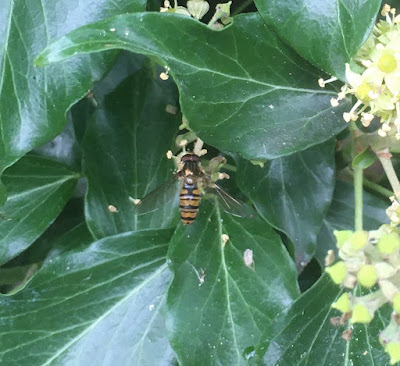After dropping the car off for a service this morning I decided to walk home via my favourite little local birding 'patch' - along the lower reaches of Ormesby Beck in North Ormesby. This is a fairly unremarkable-looking little stream, with lots of the problems you might associate with urban rivers and brooks - poor water quality, large amounts of rubbish washed downstream, a straightened course running mostly in a concrete channel, development right up to the riverbanks - but even so, over the last few years I have seen or heard at least 48 species of bird along the beck and in the grassland and woods next to it (just under 10 hectares (about 24 acres) in area).
This morning my bird-list was about half that total but it included several species which are a bit special or which I don't see very often in the area. The first bird I saw when I looked over the concrete wall next to a beck-side pub (the Navigation Inn) was a Little Egret - an elegant white heron. Unfortunately I didn't have my camera with me but was able to get three rather blurry photos with my phone which still manage to give an impression of how unnatural looking the channel is at that point, with steep walls, discarded tyres and other rubbish. You can also see, from the different position of the Egret's head and neck in the three photos that it appears to be actively hunting, so there is obviously some prey, probably small fish, there for it to catch.
A little further down the beck from where I first saw the Egret, in a slightly more natural stretch (with vegetated banks and a little bit of tidal mud, although still in a straightened channel with lots of rubbish) I saw it again but this time flying away along with a Grey Heron and a Redshank. The Redshank, which is a fairly common wading bird in the Sandpiper family, was only the second one I have seen on my local patch and I was later able to watch it for several minutes on the mud at the point where another beck, Middle Beck, comes out of its underground culvert to join Ormesby Beck above ground.
After wandering along the beck for a while, watching an over-excited flock of Long-tailed Tits (joined at times by Blackbirds, Robins, Great Tits and Blue Tits) I came back to the mouth of Middle Beck and was really pleased to see a Grey Wagtail - the first one that I have recorded here, although I've seen them several times in North Ormesby, including in my own garden (see this blog entry from last year - http://northormesbynaturalist.blogspot.com/2019/10/the-making-of-pond-and-unexpected.html). This pretty little, long-tailed bird is often misidentified by inexperienced birders as the much scarcer Yellow Wagtail, as it has a lot of yellow in its underparts. However, as well as being an unlikely visitor to an urban stream such as this, Yellow Wagtails are summer visitors to the UK and should all be on their way to Africa by now.
The next exciting thing I spotted was a Kingfisher. Although I've seen Kingfishers on this stretch of the beck on a few occasions, it has previously always been birds flying along the river, and so I didn't have any definite evidence that they were using it as anything other than a convenient corridor to fly along between better patches of habitat. However, today was the first time that I have seen one actually diving into the beck, proving that they do linger here to hunt for the little fish that they live on.
Having seen or heard 20 species of bird along 500m of the beck channel (going downstream from the Navigation Inn, Marsh Road, North Ormesby, if you want to look at it in Google Maps), I headed towards home adding a further three species to the day's list on the way - Magpie (much vilified, very common, but nonetheless beautiful), a very fast-flying Sparrowhawk, and my first Common Teal for the patch since 2017. The Teal was a male with his lovely chestnut head and bottle green 'eye-mask' and he made a great end to an unplanned bit of patch birding.








